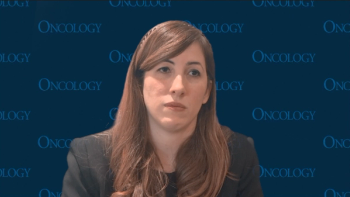
- Oncology Vol 30 No 4_Suppl_1
- Volume 30
- Issue 4_Suppl_1
(S009) Intensity-Modulated Radiation Therapy With Stereotactic Body Radiation Therapy Boost for Unfavorable Prostate Cancer: A Report on Three-Year Toxicity
Rates of clinically significant GI and GU toxicities are modest following SBRT plus IMRT. Placement of rectal spacers may decrease rectal toxicity. Future studies should also identify dosimetric predictors of these toxicities.
Ima Paydar, MD, Abigail Pepin, Joseph King, Robyn A. Cyr, Thomas Yung, Siyuan Lei, Simeng Suy, PhD, Anatoly Dritschilo, MD, John H. Lynch, MD, Thomas P. Kole, MD, PhD, Sean P. Collins, MD, PhD; Georgetown University School of Medicine; George Washington University; University of South Carolina School of Medicine; Winthrop-University Hospital
PURPOSE: Recent data suggest that intensity-modulated radiation therapy (IMRT) plus brachytherapy boost for unfavorable prostate cancer provides improved biochemical relapse–free survival over IMRT alone. Stereotactic body radiation therapy (SBRT) may be a less invasive alternative to brachytherapy boost. Here, we report the 3-year gastrointestinal (GI) and genitourinary (GU) toxicities of SBRT plus IMRT.
MATERIALS AND METHODS: Between March 2008 and September 2012, patients with prostate adenocarcinoma were treated with robotic SBRT (19.5 Gy in three fractions) followed by fiducial-guided IMRT (45–50.4 Gy) on an institutional protocol. Toxicity was prospectively graded using the Common Terminology Criteria for Adverse Events version 4.0 at the start of therapy and at 1- to 6-month intervals after therapy. Rectal telangiectasias were graded using the Vienna Rectoscopy Score (VRS). Logistic regression was used to identify baseline patient characteristics associated with toxicity.
RESULTS: At a median follow-up of 4.3 years (range: 1.7–7.5 yr), 108 patients (4 low-, 45 intermediate-, and 59 high-risk) with a median age of 74 years (range: 55–92 yr) were treated with SBRT plus IMRT, with 45% on anticoagulation initially or during treatment. The cumulative incidence of ≥ grade 2 late rectal bleeding requiring coagulation was 6.5%, with no patients requiring more than two coagulations. One patient experienced a late grade 3 GI toxicity requiring hyperbaric oxygen. No rectal fistulas were observed. Ten patients had multiple nonconfluent telangiectasias (VRS grade 2), and three patients had multiple confluent telangiectasias (VRS grade 3). The cumulative incidence of grade 3 GU toxicity was 6.5%, with no ≥ grade 4 GU toxicities. No patient-specific predictors of GI or GU toxicity were identified on regression analysis.
CONCLUSION: Rates of clinically significant GI and GU toxicities are modest following SBRT plus IMRT. Placement of rectal spacers may decrease rectal toxicity. Future studies should also identify dosimetric predictors of these toxicities.
Proceedings of the 98th Annual Meeting of the American Radium Society -
Articles in this issue
Newsletter
Stay up to date on recent advances in the multidisciplinary approach to cancer.















































































